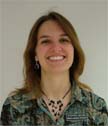The World of Stuttering at Your Fingertips: Slp Student Participation in the ISAD Online Conference
 |
About the presenter: Charlie Osborne, M.A., CCC-SLP, is a clinical assistant professor at the University of Wisconsin in Stevens Point, Wisconsin where he teaches the fluency disorders course and other courses, supervises in clinic, and provides clinical services at St. Michael's Hospital. Charlie is currently the editor of the ASHA Division 4 Perspectives on Fluency and Fluency Disorders. He has worked with children and adults who stutter for over twenty years. |
 |
About the presenterStepheni Balcsik, B.S., is a graduate student at the University of Wisconsin-Stevens Point. Stepheni's interests within the field of communicative disorders include fluency, voice, and neurogenic disorders. During her clinical practicum experience, Stepheni has participated in the diagnosis and treatment of individuals who stutter. In the future, Stepheni plans to pursue a career as a speech-language pathologist in a medical setting. |
 |
About the presenter Elizabeth Boettcher, B.S., is a graduate clinician at the University of Wisconsin - Stevens Point. She received her Bachelor's degree in communicative disorders in 2006, and is currently pursuing a Master's degree in speech-language pathology. Her chief areas of interest include neurogenic communication impairments, voice, and fluency. |
The World of Stuttering at Your Fingertips: Speech-Language Pathology
Student Participation in the ISAD Online Conference
by Charlie Osborne, Stepheni Balcsik, and Elizabeth Boettcher
Wisconsin, USA
There are many educational challenges to providing or obtaining adequate preparation for working with people who stutter (PWS). As an educator, the challenge of insuring that students acquire adequate skills and knowledge for working with PWS is a daunting one. With the recent changes in ASHA requirements, over one-quarter of academic programs have reduced the course requirements for fluency (Yaruss and Quesal, 2002). At the University of Wisconsin -Stevens Point (UWSP) courses related to fluency and fluency disorders were reduced from two to one in 2000. One result of this has been the condensing of information covered (by combining information previously covered in two courses into a single course). The determination of how much time to spend on what is a crucial one, especially given the fact that many of the practicing SLPs do not feel comfortable working with people with stuttering problems (Cooper and Cooper, 1996; Brisk, Healey, and Hux, 1997; Kelly, et. Al., 1997). There is no need to develop additional SLPs who are uncomfortable with their knowledge and skill level when working with stuttering! Quesal (2001), in his discussion of his response to this plight, described how he had reduced classtime spent on theory and had increased the time devoted to clinical application (assessment and management). Tetnowski and Roussel (2004) related how, at their university, they had increased opportunites for students to take courses in fluency and fluency disorders, along with how they had built up the university clinic's fluency caseload in their attempt to provide adequate student preparation.
Added to the instructional challenges in the classroom is the other possible roadblock and that is the likelihood of a student acquiring clinical experience with stuttering during his/her graduate education. It is a gamble at best. Fortunately, at UWSP the fluency caseload typically runs second to child phonology in terms of number of clients. We have a contract with the local school district that allows for us to see most of the 3-5 year-olds who stutter within the school district. Even with the higher fluency caseload, not every UWSP student has the opportunity to work with a PWS prior to graduating.
From the student perspective, it is enough of a challenge to develop the general knowledge and skills necessary to function effectively and efficiently at a beginning level upon graduation. If a student is interested in developing a more in-depth understanding of a specific disorder, like stuttering, it is often necessary for her/him to seek out additional learning opportunities that will help advance that understanding. The annual ISAD Online Conference, in our opinion, provides such an opportunity. The purpose of this paper is to provide our perspectives (that of student and educator) of the experience of participating in the conference.
As a part of the graduate-level Fluency Disorders course at UWSP, students are required to participate in the annual ISAD Online Conference. The unit of study is geared toward developing the student's appreciation of stuttering, how it is perceived in cultures different from their own, and possibly, how PWS have learned to cope with a stuttering problem. By participating, it is hoped that the student will develop a sense of the culture of stuttering and of the stuttering community (PWS, their family members, and professionals who work with PWS). As a part of the study unit, students are required to read a minimum of five presentations, to participate in three presentations by commenting to presenters in the threaded-discussion, and to write reactions to the experience of having participated in the event. The assignment from last year is available for those interested in more detail. Last year, students had also engaged in a self-exploration of their culture and of their awareness of others' cultures before participating in the conference.
The ISAD conference furnishes the student with an unparalleled experience. The student is afforded the chance to interact with PWS, their families, and speech-language pathologists (SLPs) who specialize in working with PWS in an international venue. While textbooks are critical in obtaining knowledge about etiology, characteristics, and intervention of stuttering, being able to read personal accounts from PWS of how they have coped and are coping with stuttering or from SLPs on how they have helped or are helping PWS and their families, provides the student with real-life, first-hand accounts about stuttering. The quality of interaction during the conference is unique. It allows a student to have personal interactions with presenters through the threaded discussions. For instance, last year, one student intitially expressed apprehension about interacting with seasoned professionals or with PWS in the discussion threads that would be on display across the world. After her first post to a presenter, she received a timely and warm response. Her initial apprehension disappeared. The presenters willingly shared their experience, knowlegdge and expertise in a nonthreatening, nonintimidating manner, allowing the student to feel comfortable posting comments and asking questions.
This is usually a student's first opportunity to engage with PWS and with other professionals who have a strong interest in stuttering. A student may be inclined to play a more active role in their education by actively participating in other professional events as a result of having had a positive experience in this conference. A student may develop a strong interest in fluency and fluency disorders as a result of participating and may, down the road, elect to specialize in the area.
Another positive from the student perspective is the opportunity to hear different perspectives regarding stuttering, other than just their professor's. Many presenters willingly provided answers to questions, or asked additional, thought-provoking questions, or supplied references to the student queries.
Where else could a student interact with such a diverse group on such a personal level? What an opportunity to read an article, to post a question or comment about an article, and to receive an almost immediate response from the author! Essentially, those interacting in the conference are all on the same journey, the exploration of stuttering. One difference in the indivduals who participate in the conference lies in how long they have been travelling on the road of exploration. The opportunity to interact with many different individuals who are at different points on the road is presented to students who are at the beginning of their professional journey. The online conference is a forum made up of a community of people from across the planet who shares a common interest. By their participation, students can become members of this community and develop connections with others. These connections may exist for the moment of the conference, but there is always the possibility that they may be longstanding.
Since students of today will be speech-language pathologists of tomorrow, active student participation in educational endeavors like the ISAD Online Conference is critical in demystifying the world of stuttering.
References
Brisk, D., Healey, E.C., and Hux, K. (1997). Clinicians' training and confidence associated with treating school-age children who stutter: A national survey. Language, Speech, and Hearing Services in the Schools, 28, 164-176.
Cooper, E. and Cooper, C. (1996). Clinician attitudes towards stuttering: Two decades of change. Journal of Fluency Disorders, 21, 119-135.
Kelly, E., Martin, J., Baker, K., Rivera, N., Bishop, J., Krizizke, C., Stettler, D., and Stealy, J. (1997). Academic and clinical preparation and practices of school speech-language pathologists with people who stutter. Language, Speech, and Hearing Services in the Schools, 28, 195-212.
Quesal, R. (2001). How do students learn if clients aren't there? ASHA Division 4 Perspectives on Fluency and Fluency Disorders, 11, 4, 8-11.
Tetnowski, J. and Roussel, N. (2004). A "rebirth" in fluency disorders. ASHA Division 4 Perspectives on Fluency and Fluency Disorders, 14, 1, 7-9.
Yaruss, J.S. and Quesal, R. (2002). Academic and clinical education in fluency disorders: An update. Journal of Fluency Disorders, 27, 43-63.
August 30, 2007

